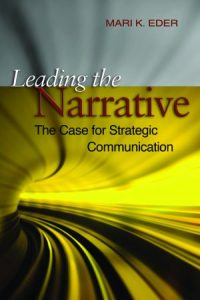 Reviewed by Matt Armstrong
Reviewed by Matt Armstrong
Leading the Narrative: The Case for Strategic Communication by Mari Eder, Naval Institute Press, 2011, ISBN: 9781612510477, 152 pp., $24.95.
Strategic Communication (SC), much like public diplomacy (PD), is many things to many people. Strategic communication, without the “s,” can be used to describe a process, or an activity. Some seem to argue that it is a bureaucracy, or at least activity to be controlled by a bureaucracy. The Defense Department defines SC as an “effort” to “understand and engage key audiences…for the advancement of U.S. Government interests, policies, and objectives” through coordinated and synchronized actions across “all instruments of national power.” The Strategic Communication Handbook version 3, also from Department of Defense, states that SC “must be a responsive and agile whole-of-government effort with synchronization of crucial themes, messages, images, and actions.” RAND’s Chris Paul suggests trying to nail down a precise definition may have little benefit: “perhaps it is fine if, like pornography, we ‘know it when we see it.’”
In today’s environment where the transactional costs of communication have become so low, there is hearty demand for resources for understanding SC, its importance, and its utility. The idea is new to some, including those who have little concern for public opinion. But with the virtual disappearance of the traditional boundaries of time, distance, cost, language, and authority, everyone from the general, to the “strategic corporal,” or the “strategic trash man,” can potentially wield strategic influence through creating, reinforcing, or undermining a narrative, regardless of intent.
The book Leading the Narrative: The Case for Strategic Communication purports to be a “primer on the art and science of strategic communication.” The Naval Institute Press published the book in November 2011. The author, Mari Eder, is a U.S. Army public affairs officer with experience in public relations. The book is offered as providing useful analyses and lessons for strategic communication in today’s complex environment of multiple voices and agendas. By the description and the title, one would expect a discussion on narratives and engagements that span communication mediums, organizations and time.
Unfortunately, instead of providing useful advice for commanders and policy makers today, the book is a compilation of shallow snapshots of the past framed through grumbling reminiscent of Spiro Agnew’s “nattering nabobs of negativism.” The nostalgia for centralized information dissemination, and near disdain for engagement, and for a “hypodermic needle” style of communication is palpable.
Sadly, despite being published only last year, this is not a modern resource on a dynamic topic that has been the subject of such substantial analysis and reflection in reports, books, and conferences. Most of the chapters were written years before and published as standalone articles by the author between 2007 and 2010, with only a few chapters apparently written specifically for the book. In short, the book’s 152 pages is a collection of articles cobbled together into a cumbersome, shallow, limited, and sometimes contradictory review of strategic communication from the public affairs perch. The book lacks the context, useful lessons, and unique insights to be useful.
From the first sentences, the author shows her hand and bias, invoking, in spirit if not in word, the oft-repeated mantra of public affairs that one can inform without influencing: “All communication informs.” All communication conducted with intent does more than merely inform. It educates, reveals, restricts and can elicit strong emotion.
The uninformed may find the book of some interest, but the informed reader will find nothing but frustration. For example, Eder commends the military, and briefly the State Department’s, increased ability to react in a global media environment, and cites, among others, former Secretary of Defense Donald Rumsfeld addressing the Council on Foreign Relations in 2006 on how the U.S. is better at responding across different mediums. Ignored are the underlying issues of narratives and the need to shape or get in front of a story. Typical of the book, there is no mention of how SC (or public affairs) evolved, or the fits and starts and repercussions of both, in the five years following Rumsfeld’s talk.
There is a brief mention of the importance of Information as part of the DIME national power model (Diplomacy, Information, Military, Economics), but even that discussion is flawed. While invoking the whole-of-government concept of power, Eder barely sticks a toe outside of her public affairs “silo.” The only interagency reference is a short mention of the State Department. Eder praises Karen Hughes for establishing “rapid reaction centers” abroad as a “welcome change.” The media hubs, as they are called today, and the pronouncement by Hughes to be at the foreign policy table are presented as if they happened yesterday. Eder clearly believes that the State Department has done nothing significant in terms of strategic communication or narratives since Hughes resigned as Under Secretary in 2007.
The chapter praising better reaction by State and Defense also tells us that Defense Public Affairs “have been responsible for tremendous innovation.” The reader, however, is left to wonder about the “innovation” as Eders leaves out examples.
In a jarring example of the natural challenges of pulling together articles on an evolving topic, the chapter that immediately follows praise for reaction is followed by another – written two years later (February 2009) – which is critical of the emphasis on reaction: “We react. We do not act.”
Eder does spill some ink to mention the lack of leadership in strategic communication. There is, she tells us, a lack of a “national security strategy for strategic communication,” citing a May 2008 report by the Heritage Foundation. Eder has a chance to dissect the implications of absent leadership, but instead her desire for control directs her narrative. “Perhaps the greater travesty,” Eder writes, “is the growth of boutique strategic communications organizations, in different parts of various Defense agencies, all with different missions and application of what each thinks its strategic communication turf is.” As is typical with the book, the reader is left without understanding the different “turfs,” missions, or applications, or how the development is a problem, let alone a “greater travesty.”
The true “travesty” is that between the May 2008 Heritage report cited by Eder and 2011, there were significant public discussions about a “national security strategy for strategic communication” and significant discussions on strategic communication as it relates specifically to the Defense Department. There was, for example, a report published by the White House (read: the National Security Staff), as required by the Congress, on a “comprehensive interagency strategy for public diplomacy and strategic communication.” Even if the document did not include a strategy, its aspiration toward centralized leadership is noteworthy, as was the Pentagon’s own report, also as required by the Congress, on how the executive was organized for strategic communication. Eder could have cited, lauded, or criticized other reports since May 2008 and before 2011 on strategic communication, including anything by the U.S. Army War College’s Dennis Murphy, such as the 2009 “In Search of the Art and Science of Strategic Communication” or the 2008 “The Trouble with Strategic Communication(s).” It is entirely possible, even likely, that these and other resources were discriminated against because they start with the premise “to inform is to influence,” the idea that is antithetical to many public affairs officers, including apparently Eder.
Social media, Eder writes, is a plague that contributes to a “toxic and volatile” information environment. In stark contrast to an Army general, also in public affairs, who developed and advocated the “4-E’s” — educate, empower, equip, and encourage — engaging across social media, Eder fears it and suggests the only solution is systemic control. “Today leakage is not only a possibility but also extremely difficult to prevent. This is a true design flaw (problem) and not a user issue (symptom).”
Media is not much better than “social media” to Eder. In fact, they are close to the same: “Perhaps one longstanding reason for the lack of public discussion regarding media ethics is that journalism is not a true profession” because “it lacks standards of admission.” These statements are surrounded by frustration and not advice. Indeed, Eders laments that the media, social or otherwise, writes what they want and not what you want them to write.
The abundance of references to reports and speeches of the past, most of which are irrelevant to forward-looking research today caused me to take a close look at the author’s references and her bibliography. What I found was not surprising. For example, the chapter entitled “The Cable, the Dish, and the Blog: Media Communication Ethics,” the book’s “new media” chapter, excluding two outliers (the Constitution and an article from 1945), the median year of the references was 1995. That would not be bad if the chapter was packed with original and groundbreaking analysis and suggestions, but it is not. The median publication year of her bibliography is June 2000. After reading this book, I was not surprised at the lack of timely resources.
Like technology, a lot has changed in the past five years in strategic communication. This book does not reflect these changes, or the substantial and worthwhile discussions about them over the past three years. This book is a complaint anchored in time. Eders ignores all of the significant discourse on, or around, strategic communication of the last several years, all of which moves the ball on the concept and practice of strategic communication, and narratives, far beyond where Eders leaves the reader. The book is absent a narrative of strategic communication and devoid of any useful discussion about narratives. It is at most a confusing grouping of historical anecdotes without context. The take-away from this book is that many “strategic communication leaders,” including the author, still do not understand the nature and imperative of today’s communication environment.![]()
American Diplomacy is the Publication of Origin for this work. Permission to republish is freely granted with credit and a link back to American Diplomacy

Mr. Armstrong is a consultant, lecturer, and author on public diplomacy and strategic communication. He was the Executive Director of the U.S. Advisory Commission on Public Diplomacy, the only organization charged by the Congress to provide oversight over Government activities that intend of understand, inform, and influence foreign publics. He blogs at www.MountainRunner.us
